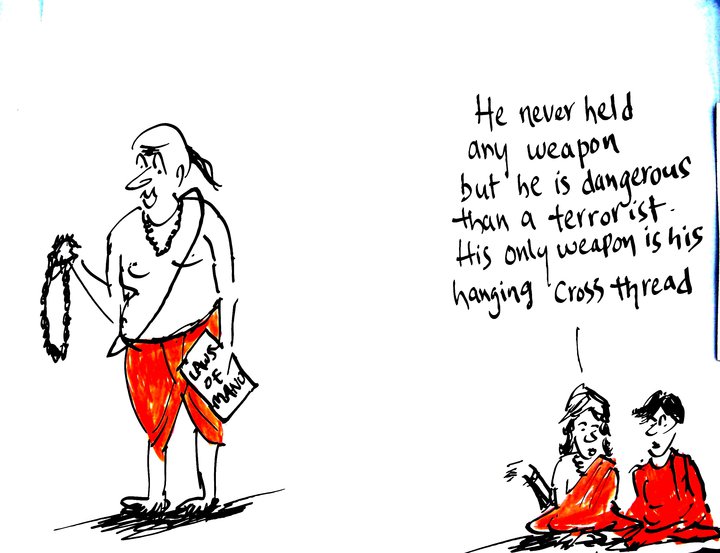Pranav Jeevan P
 Why is the assertion of Bahujans branded as identity politics based on caste, but the savarna assertions are termed as “culture”, “tradition” and “merit”? The dominance of rituals and performance of savarna hegemony is the sign of cultural penetration of caste hierarchies in all sections of society. It is the institutions which are controlled by them which grant them a distinctive identity which is dissociated from any caste connotations. This frees them to utilize and showcase their cultural and social capital with greater legitimacy as they claim it is devoid of caste and the thousand years of oppression of Bahujans it carries with it.
Why is the assertion of Bahujans branded as identity politics based on caste, but the savarna assertions are termed as “culture”, “tradition” and “merit”? The dominance of rituals and performance of savarna hegemony is the sign of cultural penetration of caste hierarchies in all sections of society. It is the institutions which are controlled by them which grant them a distinctive identity which is dissociated from any caste connotations. This frees them to utilize and showcase their cultural and social capital with greater legitimacy as they claim it is devoid of caste and the thousand years of oppression of Bahujans it carries with it.
This article tries to introduce the work of French sociologist, anthropologist and philosopher Pierre Bourdieu who analyzed the dynamics of power in society, especially the diverse and subtle ways in which power is transferred and social order is maintained within and across generations. He introduced the influential concepts of cultural, social, and symbolic forms of capital (as opposed to traditional economic forms of capital). In his book, Distinction: A Social Critique of the Judgment of Taste (1979)1, he argues that judgments of taste are related to social position, or more precisely, are themselves acts of social positioning. His work emphasized how social classes, especially the ruling and intellectual classes, preserve their social privileges across generations despite the myth that contemporary post-industrial society boasts equality of opportunity and high social mobility, achieved through formal education2.
Bourdieu criticized the importance given to economic factors by Marxists in the analysis of social order and change. He instead stressed on the capacity of people to reproduce their culture and how symbolic systems plays an essential role in the reproduction of social hierarchies. He defined Symbolic violence as the capacity of a dominant group to ensure that the arbitrariness of the existing social order is either ignored, or deemed natural, thereby justifying its legitimacy. As an example, he shows that despite the apparent freedom of choice in the arts, people’s artistic preferences (classical music, traditional music, pop, rock, rap) strongly tie in with their social position; and showing that subtleties of language such as accent, grammar, spelling and style—all part of cultural capital are a major factor in social mobility (getting a higher-paid, higher-status job)1. This is very evident in the Indian caste society where savarnas have the collective narcissism to claim everything that is dominated by them as the “classic” or “pure” forms and anything connected or produced by Bahujans as mediocre. It is not surprising that the Bahujans don’t find themselves represented or included in these savarna spaces.
People develop unconscious strategies suited to their position in the social hierarchy and react to the world depending on the social structures present in it. This gives rise to opinions, tastes, tone of voice, body movements, mannerisms etc. which will show his position in the social order. Performing these habits acknowledge, legitimize and reproduce the social forms of domination and prejudices and people will accept their position as self-evident or natural discarding the possibility of an alternative social order and power relations1. This also gives rise to deep founded, learned unconscious beliefs and values which are accepted as truths that dictate a person’s actions and thoughts within that social hierarchies. These beliefs tend to favor the existing social hierarchies privileging the dominant castes and taking their position on top as canonical. These are further cemented by the religious and spiritual monopoly of the dominant castes in creating myths and stories that glorifies and legitimizes their apex position. They create and regulate rituals and practices that ultimately tend to reproduce these same hierarchies in future generations.
The conditions in which the individual lives generate dispositions compatible with these conditions including tastes in art, literature, food, and music. The most improbable practices are therefore excluded, as unthinkable, by a kind of immediate submission to the social order that inclines people to make a virtue of necessity, that is, to refuse what is categorically denied to them3. The internalization of patriarchy by women, of caste and the limitations and injustices it creates as natural or karma by Bahujans can be considered to be part of this social learning which is also reinforced by the Vedic religion which gives a glorified angle to it. Any aspirations for change from Bahujans where even having the same aesthetic dispositions, like wearing a mustache, is seen a threat to the social order by the dominant castes and is immediately attacked and demonized.
Bourdieu sees symbolic capital (e.g., prestige, honor, attention) as a crucial source of power2. Symbolic violence is when savarnas use their symbolic capital against Bahujans to control and alter their actions. Symbolic violence is fundamentally the imposition of categories of thought and perception upon Bahujans who then take the social order to be just. It is the incorporation of unconscious structures that tend to perpetuate the structures of action of the dominant castes. The constant transmission in media and art houses which glorifies savarna tastes as “classical”, their food habits are superior etc. and the complete lack of Bahujan representation and their taste in these narratives is symbolic violence. Bahujans will then accept their position to be “right.” Symbolic violence is in some senses much more powerful than physical violence in that it is embedded in the very modes of action and structures of cognition of individuals, and imposes a spectre of legitimacy to the social order2.
Educational success, especially in higher education, entails a whole range of cultural behaviour, extending to completely non-academic features like gait, dress, or accent. Privileged savarna children have learned this behaviour, so have the savarna professors. Children of under-privileged backgrounds have not. The children of savarnas therefore fit the pattern of their savarna teachers’ expectations with apparent ‘ease’. The Bahujan kids are ones who are found to be ‘difficult’. Bourdieu regards this ‘ease’, or ‘natural’ ability as in fact the product of a great social labour. The lack of these learned behaviours or tastes which savarna kids possess is being fondly called as “merit”. For example, Bourdieu chastises academics for judging their students’ work against a rigid academic vocabulary, favoring students whose writing appears ‘polished’ and simultaneously pulling down those guilty of being ‘crude’4. The professors will unconsciously reproduce a degree of caste prejudice, promoting the student with higher linguistic capital and holding back the student who lacks it—not because of the objective quality of the work but simply because of the quality of language in which it is written.
This is very evident in our higher education spaces which are completely exclusionary to Bahujans. In IIT Bombay, recent RTI shows that more than 97% of faculty recruited hail from general category and reservation norms are violated openly. Since these savarna dominated faculty members conduct interviews of PhD admission, their caste prejudice is apparent in them selecting more students from their own dominant caste backgrounds who come with higher linguistic and cultural capital than Bahujan students. This difference of social and cultural capital which the dominant caste possess is what they call “Merit” as they decide what should be the parameters for being “meritorious” and their parameters will always be suited to savarna tastes and create spaces inaccessible to Bahujans. Every quality that is attained through caste capital is deemed as markers of merit, like English speaking, private school mannerisms, use of academic jargon, being vegetarian etc. The degree to which one’s social origin affects these preferences surpasses both educational and economic capital. Demonstrably, at equivalent levels of educational capital, social origin remains an influential factor in determining these dispositions. This is why it is necessary to have adequate Bahujan representation in faculties of all higher educational institutions if there has to be any hope for inclusion and justice for Bahujan students.
Savarnas keep proclaiming castelessness even after being the greatest beneficiaries of the socio-cultural gains they get from their caste. They need to use this to claim legitimacy for their own legacies and also need this to be used against Bahujan assertions which are primarily based on caste. Therefore, savarnas have created a transformation exercise to convert the caste capitals they gain into modern individualistic capital which cannot be easily identified with caste. They made their tastes as the dominant notions of culture and traditions so that no one will confuse these with their caste and they can easily use their social and cultural capital without bringing up the casteness associated with it. They will claim it as anything but caste. This forced dissociation of caste with their socio-cultural capital is to delegitimize the Bahujan voices which are assertive of their rights which are denied to them because of casteness. This is to strengthen their argument that we are not using caste anymore, so you shouldn’t do it either, when in reality they are using their caste for gains all the time.
Cultural capital refers to assets (e.g., competencies, skills, qualifications) which enable holders to mobilize cultural authority and can also be a source of misrecognition and symbolic violence2. For example, Bahujan children are always taught to see the educational success of their savarna peers as legitimate, seeing what is actually the result of historic caste oppression and discrimination as instead the result of hard work or even ‘natural’ ability. A key part of this process is the transformation of people’s symbolic or economic inheritance (e.g., accent or property) into cultural capital (e.g., university qualifications) which is shown to be casteless.
Social capital is the sum of the resources, actual or virtual, that accrue to an individual or a group by virtue of possessing a durable network of more or less institutionalized relationships of mutual acquaintance and recognition. Cultural capital is accumulated over a period of generations as they adopt cultural investment strategies and pass them on to their children. This gives children an opportunity to realize their potential through education and they pass on those same values to their children. Over time, individuals in such families gain cultural currency which gives them an inherent advantage over other groups of people, which is why there is such variation in academic achievement in children of different social classes. Having such cultural currency enables people to compensate for a lack of financial capital by giving them a certain level of respect and status in society. Bourdieu believes that cultural capital plays a role when individuals pursue power and status in society through politics or other means. Social and cultural capital along with economic capital contribute to the inequality we see in the world5.
Any Bahujan who raises the question of lack of representation and historical injustices will be immediately branded as using caste politics but a savarna who uses the merit argument against reservation will not be accused of using caste. The savarnas have already converted their caste capital into property, higher education, and dominance in lucrative jobs so that they can claim to be casteless or caste blind. So, they need to delink these socio-cultural gains from caste to demand legitimacy for being the “natural” holders of these capital. Else, every gain of theirs will be seen from the scrutiny of caste oppression which goes against their myth of individual capabilities and “merit”. This legitimization of social capital accumulation by savarnas by reconstituting the inheritances of family and community networks into an inherent “merit” which is “completely devoid of caste” is the success of the educational institutions which are managed and run by them. They convert these social and cultural capital gained through caste into individual degrees and qualifications which are showcased as “pure merit” and can be used in the market. Savarnas across India have now embraced “merit” as a collective narcissistic caste trait that distinguishes them from Bahujans.
Bourdieu takes language to be not merely a method of communication, but also a mechanism of power. The representation of identity in forms of language can be subdivided into language, dialect, and accent. The language one uses is designated by one’s social position. This determines who has a “right” to be listened to, to interrupt, to ask questions, and to lecture, and to what degree6. This difference is easily seen in higher educational spaces where students from underprivileged backgrounds are silenced constantly and mocked for their lack of linguistic capital. This hierarchy is also reproduced in groups where savarnas are “natural” leaders who are considered more eloquent and should be listened to.
Bourdieu claims that one’s choice of taste and aesthetics depicts one’s social status and separates oneself from lower groups. Each caste teaches their aesthetic preferences to their children and they internalize these tastes at an early age and it guide the young towards their appropriate social positions and behaviors that are suitable for them, and creates an aversion towards other behaviors1. Those attributes deemed excellent or “classical” are shaped by the interests of the dominating caste. This is why every savarna art or cultural symbols are considered to be of higher value than Bahujan symbols. For example, we call the music produced by savarnas as “classical” and is held to a higher pedestal than Bahujan music. Holding that view is not considered casteist but a Bahujan musician who uses the traditional Bahujan instruments is immediately branded as using their caste. This decoupling of savarna tastes from caste makes them appear modern, casteless and legitimate. Tastes in food, culture and presentation are indicators of caste because trends in their consumption seemingly correlate with an individual’s position in the social hierarchy.
This cultural domination of savarnas in our daily life and society has been perpetuating for so long that it’s hard to identify it anymore. Everything which we see as devoid of caste and part of modernity can be traced mostly back to savarna dominance. For example, the white and golden Kerala saree which is now considered as the cultural symbol of Kerala women is derived from traditional attire of Brahmin and Nair women. No one considers it as a caste symbol today. Since most practices and symbols of savarnas are now converted into modern forms, it is hard to connect them to caste, and these savarnas conveniently use them in their favor without being flagged casteist.
Bourdieu believes that “the strongest and most indelible mark of infant learning” would probably be in the tastes of food1. The entire militant vegetarianism and notion of “purity” accorded to it shows how the Brahminical ideas of taste is considered as canonical and how that idea is perpetuated through cultural domination. Their demand for separate eating spaces and disgust for meat eaters shows the blatant casteist and exclusionary nature of how food preferences are used to cement their dominant status.
The analysis of how power is used and practiced can be used to understand the power held by the savarnas in Indian society and how through various customs and practices that power is consolidated and passed from generation to generation as different kinds of capital. It is the failure of many Indian savarna Marxists to ignore the accumulation and use of symbolic, social and cultural capital by savarnas and reducing all oppression to class conflict over economic capital. Ambedkar realized the importance of social change and destruction of caste hierarchies for any kind of economic and political revolution to take place in India. He understood that any society in where caste exists, the dynamics of power will work against women, Bahujans and other minorities and no justice or democracy is possible in such a society.
Bahujans need to be aware of these practices which are used by savarnas to portray them as modern and casteless while simultaneously enjoying all the privileges and capital associated with it. This is a carefully crafted agenda by savarnas to delegitimize Bahujan struggle. Bahujans need to scrutinize all the practices propagated in the name of “tradition”, “culture” and “merit” and connect them back to the caste dominance of savarnas. This is essential to delegitimize their arguments of modernity and castelessness and dethrone the savarna hegemony and strengthen Bahujan assertion for our rights.
~
References
[1] P. Bourdieu, Distinction: A Social Critique of the Judgment of Taste, Harvard University Press, 1984.
[2] “Wikipedia,” [Online]. Available: https://en.wikipedia.org/wiki/Pierre_Bourdieu. [Accessed 24 April 2021].
[3] P. Bourdieu, “Structures, Habitus, Practices,” in The Logic of Practice, Stanford, Stanford University Press, 1990, pp. 52-79.
[4] P. Bourdieu and J.-C. Passeron, The Inherotors: French Students and their Relations to Culture, Chicago: University of Chicago Press, 1979.
[5] P. Bourdieu and L. Wacquant, An Invitation to Reflexive Sociology, Chicago: University of Chicago, 1992.
[6] P. Bourdieu, Language and Symbolic Power, 1991.
~~~
Pranav Jeevan P is currently a PhD candidate in Artificial Intelligence at IIT Bombay. He has earlier studied quantum computing in IIT Madras and Robotics at IIT Kanpur.










